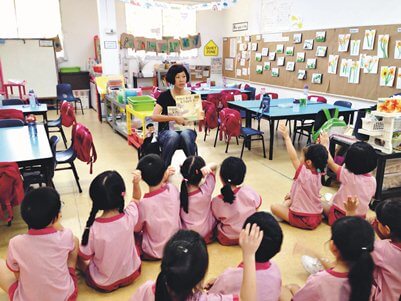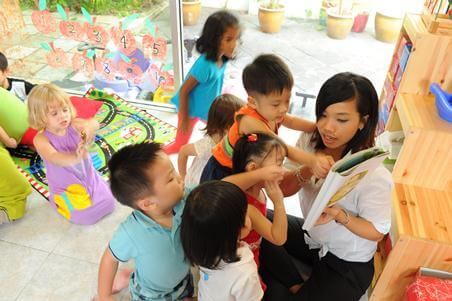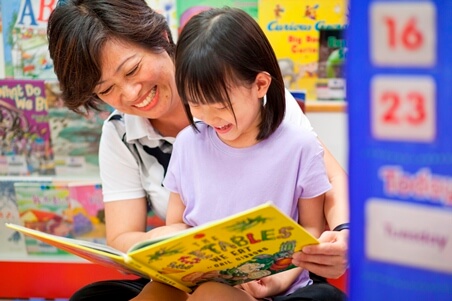Happily Ever After


Singaporean author Emily Lim has written more than 30 children's books and won international awards for at least four of them, including Prince Bear and Pauper Bear and The Tale of Rusty Horse. Reading with young children, she says, helps them to pick up words they need to use to communicate. Ms Lim, 44, has been reading to her son, Caleb, since he was three months old. She believes her efforts played a part in Caleb being an early talker. Caleb, now four years old, can also tell his own simple stories.

Ms Lim shares with Beanstalk her advice on reading to children, what makes a good book, and how to choose those that will be of maximum benefit and interest to little ones.
WHAT MADE YOU WANT TO WRITE BOOKS FOR CHILDREN?
I wrote my first children's book in 2007 when I entered the Singapore Book Council competition. There was prize money and a chance to be published. That was the initial motivation.
YOU WENT ON TO PUBLISH MORE THAN 30 TITLES. WHAT HAS KEPT YOU GOING?
After my first book, Prince Bear and Pauper Bear, the feedback and response I got from readers made me want to continue writing. Two episodes stand out. A friend read Prince Bear and Pauper Bear to her three-year-old daughter at bedtime. Usually, after a story, the girl would say, 'Good night, mummy.' This time, she said, 'Good night, pauper bear. Don't be scared, I will be your friend.' I was surprised and touched that she understood the story and empathised with the character.
The second incident was at my first public book reading event. I was on the final page and had just read the line, 'As it turns out the boy had enough room in is heart for two bears.' I notices a father with two young children, one on each side of his lap. He turned to them and said, 'And it's just like how papa has enough room in my heart for the two of you.' That really blew me away -- it was as if the words in my book had come to life.
WERE ANY OF THE STORIES YOU'VE WRITTEN INSPIRED BY YOUR SON CALEB?
Caleb has inspired me a lot, with the funniest things he says and does. I have a notebook where I write them all down, and I guesss one day that will spark off ideas for a book. My latest picture book Tibby, the Tiger Bunny was inspired by Caleb before he was born. He was due to arrive during the Chinese New Year week in 2011, so it was between the week of the Tiger [in the Chinese Zodiac] and the week of the Rabbit. I didn't know when he was going to be born -- that was how my character of a Tiger Bunny came about.
SO YOU ALWAYS HAVE HIM IN MIND WHEN YOU WRITE NOW?
I keep him in mind in the sense that, as a mother, I'm always thinking about issues I would like him to learn or take away from a book. I would like to write about him as a character, but I've not come up with the 'perfect' book for him yet.
THERE ARE SO MANY CHILDREN'S BOOKS AVAILABLE, HOW DO WE PICK A SUITABLE ONE FOR A CHILD?

A lot depends on the child's needs. Parents and educators [because of their interactions with the child] will find out what these needs are. What I understand, from talking to educators as well as children, is that many pre-schoolers have a strong need to fit in. At their age, they are trying to find their identity and their place in the world, and they want to be accepted by their friends. They relate to characters who feel lonely or discouraged, but of course the story must also give them hope and encouragement. That helps a child make sense of his or her world. Because they are so young, it's very much through these books that they pick up new experiences and grow from them.
IN WHAT WAYS CAN A GOOD BOOK BENEFIT A CHILD?
I wrote I Can Do It for the Ministry of Education Pre-school Education Branch in 2012, about a parrot who couldn't speak well but is encouraged by his older brother, and who didn't give up. A teacher shared with me about a special needs child in her class who struggled with confidence and speaking. After hearing the story, the rest of the class encouraged the child with special needs during an activity he had been afraid to try. It was very encouraging to me that the children applied what they gleaned from the story to their own environment.
OF ALL YOUR BOOKS, WHICH IS CALEB'S FAVOURITE?
He is highly amused by my Baby Panda because the Panda is very naughty and doesn't want to eat or listen. Interestingly, Caleb is quite similar, so he thinks it's very funny.
HOW HAS READING TO CALEB FROM A YOUNG AGE HELPED HIS DEVELOPMENT?
I started reading to Caleb when he was three months old. From the onset I've spoken to him in proper sentences. I think that's why he started speaking at a very young age. At nine months, he was speaking many single words, and the moment he passed one year, he was doing two words combined. This has benefitted his socio-emotional development. He' a very confident speaker so he's usually the one to start a conversation with other children; and he's able to put words to his feelings when he's angry or upset. [The ability to do this by children] is important as it helps adults better understand the child. I'm also able to have many conversations with Caleb.
WHAT KIND OF BOOKS DO YOU RECOMMEND THAT PRE-SCHOOLERS START WITH?

For younger children, start with picture books that don't have alot of words. Their attention span is short so read books that are fun. One of the earlier ones I read to Caleb is called Hug. There are only three words in it, but that's fine. What I did with Caleb was to flip through the pictures and talk about them. From there, Caleb learned the concept of hugging, and he hugs me every day.
PLEASE SHARE WITH US YOUR TOP TIPS TO ENGAGE CHILDREN DURING STORYTIME.
- Go with the child's interest. Find out what your child likes - be it cars, dinosaurs or bunnies - and look for picture books with similar characters they can relate to.
- Really enjoy reading to them. When reading to children, it should be for the pleasure of wanting to read to them, rather than wanting to teach them.
- Adopt an interactive posture. Create excitement by talking through the pictures in the book, pausing through a reading and asknig questions. If children show interest in a particular page, let them talk about it for as long as they want.
Emily shared more tips with Beanstalk on how to nuture a love for reading in young children. To read more, click here!
HOW CAN PARENTS AND EDUCATORS ENCOURAGE PRE-SCHOOLERS TO TELL THEIR OWN SIMPLE STORIES?

One way is for parents and educators to tell them stories. I make up stories to Caleb, and he will add on to them; it doesn't matter how silly they are. Recently, he actually told me a whole story he made up himself, about superheroes. You can also take a picture book, read it with them, and encourage children to think of alternative endings. Educators can also invite local authors to visit pre-schools, so the children can hear the authors share the stories that go into writing a book. I was once invited to give a talk at a kindergarten, and the children were so excited! First, to find out I am alive, because many authors of popular children's books are no longer around, and second, to learn I am from Singapore!
Emily was featured in ECDA's Beanstalk Magazine (Jul - Sep 15 issue). Click here to read the article!
You may also like

From Cabin to Classroom: Journey of an Outstanding Early Childhood Educator
The PDP modules allowed me to get creative with lesson ideas and keep up with the ever-changing Early Childhood sector.

Ms Farhana Binte Mohamed Hassan
Early Years Educator - PCF Sparkletots @ Pioneer Block 987D (CC)

More Than Just a Place for Food
Young children are highly inquisitive, and learn most effectively with activities that allow exploration and experimentation.

Kinderland @ Yio Chu Kang

Little Fingers Create Great Art - A Community Project by Kinderland and Skool4kidz
I believe this collaborative effort is a very meaningful contribution to the SG50 celebrations.

Kinderland and Skool4Kidz